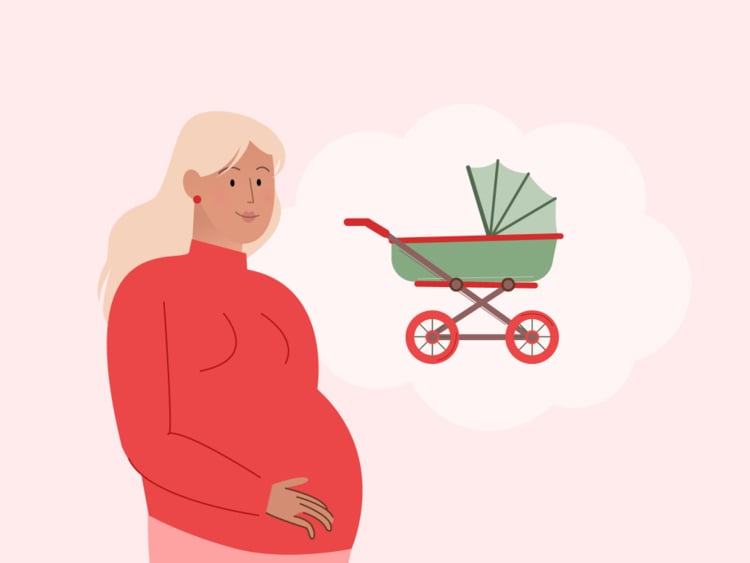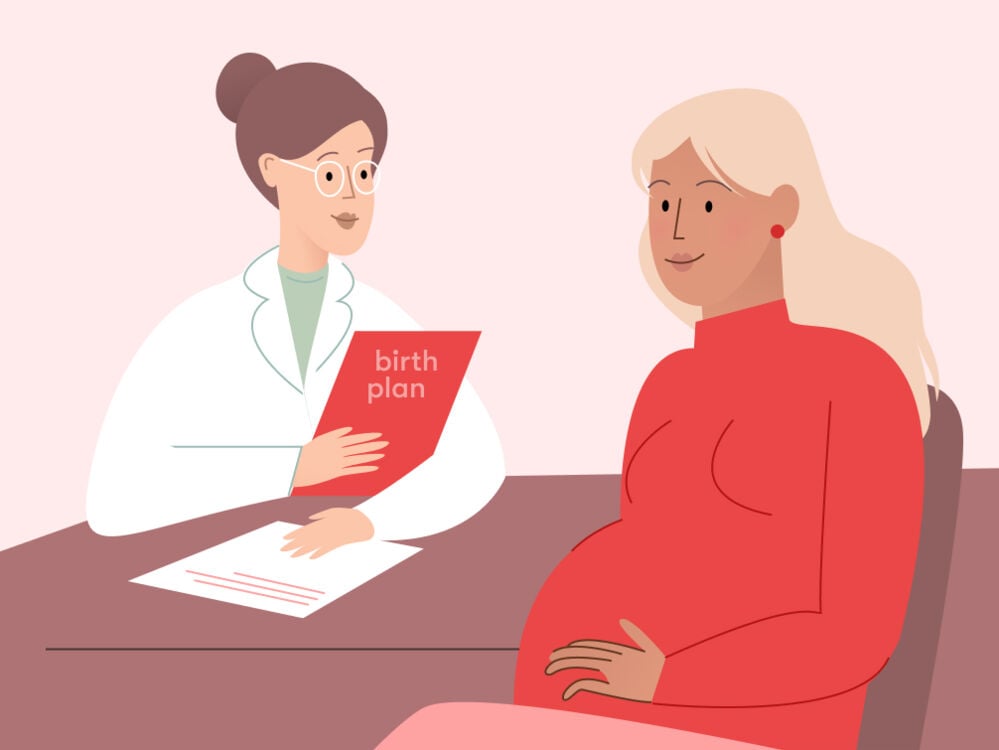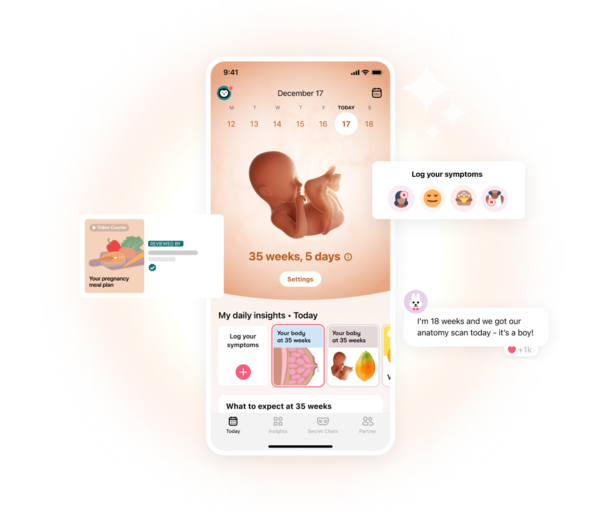By the time you reach 28 weeks pregnant and beyond, you’re counting down to your due date. But what third-trimester pregnancy symptoms can you expect, and why?
-
Tracking cycle
-
Getting pregnant
-
Pregnancy
-
Help Center
-
Flo for Partners
-
Anonymous Mode
-
Flo app reviews
-
Flo Premium New
-
Secret Chats New
-
Symptom Checker New
-
Your cycle
-
Health 360°
-
Getting pregnant
-
Pregnancy
-
Being a mom
-
LGBTQ+
-
Quizzes
-
Ovulation calculator
-
hCG calculator
-
Pregnancy test calculator
-
Menstrual cycle calculator
-
Period calculator
-
Implantation calculator
-
Pregnancy weeks to months calculator
-
Pregnancy due date calculator
-
IVF and FET due date calculator
-
Due date calculator by ultrasound
-
Medical Affairs
-
Science & Research
-
Pass It On Project New
-
Privacy Portal
-
Press Center
-
Flo Accuracy
-
Careers
-
Contact Us
Third-trimester pregnancy symptoms: What happens in the last months of pregnancy and why


Every piece of content at Flo Health adheres to the highest editorial standards for language, style, and medical accuracy. To learn what we do to deliver the best health and lifestyle insights to you, check out our content review principles.
You’re finally in your third trimester. You’ve done your stroller research, and with all the prenatal appointments you’ve had by now, you might feel like you know your doctor better than some of your own colleagues. The countdown to your due date is on.
And while you may (understandably) be focused on the moment that you’ll see your baby for the first time, there are still some third-trimester pregnancy symptoms you might have to contend with. By this point, you’ll know that pregnancy can throw some pretty weird and wonderful symptoms your way — and normally you can blame the changes on your hormones.
By the beginning of week 28 (the official start of the third trimester), your body still has a little bit more changing to do to prepare you for birth. Here, a Flo expert outlines which third-trimester pregnancy symptoms you can expect and why they’re happening.
Third pregnancy trimester: What can you expect?
The third trimester of pregnancy can feel like a strange time. Your body is getting ready to welcome your baby into the world, and alongside conversations about symptoms, your doctor will likely want to talk to you about your birth plans.
The nausea that might have characterized your first trimester will probably have ended, and you’ll likely feel much bigger than you did during your second trimester. If you're using an app like Flo for Pregnancy, you can find out what changes you might expect as you follow your baby's growth week-by-week.
Dr. Charlsie Celestine, obstetrician and gynecologist, New Jersey, US, explains that your doctor’s priority at this stage is to make sure both you and your baby are healthy.
“We see you more frequently to make sure everything is progressing normally,” she says.
Your baby could be born from 37 weeks onward and still be considered “term.” Once you reach this date, you’ll see your health care provider more. “Labor could start at any time,” says Dr. Celestine.
Take a quiz
Find out what you can do with our Health Assistant
Common third-trimester pregnancy symptoms
Understandably, with labor on the horizon, you might be more aware of every new twinge, pain, and rumble. It can be useful to read up on some of the third-trimester symptoms that you might expect.
A warning: Some of the aches you experience in the last weeks of your pregnancy can feel an awful lot like labor, but that doesn’t always mean they are.
Braxton Hicks contractions
When you’ve got your hospital bag by the door and your doctor on speed dial, the last thing you need is to be tricked into thinking you’re in labor. However, that’s exactly what Braxton Hicks contractions (or false labor contractions) are.
They can feel like mild contractions and tightness around your tummy. This is your uterus muscles practicing for when you’re in labor for real. There’s no clear explanation as to what makes them happen or when they do.
Want to know how to tell the difference between Braxton Hicks contractions and real contractions? Braxton Hicks are irregular, meaning they can last for less than 30 seconds or up to two minutes. Real labor contractions initially last between 30 seconds and 90 seconds. You’ll feel Braxton Hicks contractions at the front of your bump, while labor contractions generally start in the middle of your back and wrap around your abdomen. And, perhaps most importantly, your cervix doesn’t dilate when you’re having Braxton Hicks, but it will with real contractions.
Constipation
Your hormones work overtime throughout your pregnancy, and that’s why you can so often blame them for some of the interesting symptoms you might have experienced. One side effect you might not have expected is being constipated in the run-up to birth.
Constipation in your third trimester can be really uncomfortable, but it’s easily explained. At the beginning of your pregnancy, levels of the hormone progesterone rise, and they stay that way throughout pregnancy. As a result of this, your digestive system slows down. This means that you process your food a lot slower, potentially causing constipation.
If you’re struggling to poop, your health care provider might recommend that you up your fiber intake in your diet, drink lots of water, or take a supplement.

Hemorrhoids
Since we’re discussing constipation, we may as well take a hop, skip, and jump over to the topic of hemorrhoids (pregnancy isn’t always a glamorous time). Unfortunately, the two often go hand in hand during pregnancy. Hemorrhoids can develop because of your uterus growing and can be exacerbated by constipation.
They look like swollen red lumps around your anus. You might also notice a small amount of bright red blood in the toilet bowl right after you poop, an itchy anus, and/or pain around your anus.
They happen when — brace yourself — pressure is put on the veins around your rectum because your uterus has grown and your blood volume has increased during pregnancy. More pressure can be added if you have constipation.
It might sound intense, but you don’t need to suffer from hemorrhoids alone. Let your health care provider know what’s going on.
Shortness of breath
Has walking up the stairs turned into a mini exercise session as opposed to simply a means to get to another room? Shortness of breath is really common in your third trimester. In fact, around 60% to 70% of people report feeling a little bit out of breath in the months leading up to their due date.
It might feel uncomfortable, but there’s a reason why it happens. Not only is your baby’s weight pushing onto your abdomen (leaving less space for you to breathe deeply), but your uterus may be pushing your lungs and diaphragm upward. Increased levels of progesterone could also make you breathe a little bit quicker.
While shortness of breath can be pretty common, you shouldn’t struggle to breathe when you’re pregnant. If you have chest pain, dizziness, or anxiety, then reach out to your doctor.
Varicose veins
Have you noticed that the veins in your legs have become much more visible in your third trimester? If so, you may have varicose veins to thank. The increased pressure on the blood vessels around your tummy makes it harder for the blood to travel upward through the veins, dilating them.
During pregnancy, you have anywhere between 20% and 100% more blood circulating around your body. This is to support your baby’s growth and the development of your placenta. The good news is that in many cases, varicose veins completely clear up or reduce a lot after you’ve given birth. And if you’re concerned about them, then speak to your health care provider.
Needing to pee more often
Sleeping through the night without having to get up to pee might feel like a distant memory, and that’s because as your baby grows, it will put more pressure on your bladder. This means that throughout your third trimester, you might need to pee a lot more, and you might leak a little bit. All we can suggest for this one is to try to grin and bear it, and to remember that once the baby is here, you’ll get some much-needed bladder relief!
Swelling in your ankles and feet
It’s not just your midsection that changes a lot during pregnancy. As your baby grows, it can affect the circulation of blood to your ankles and feet. Because of this, fluid may build up in the lower areas of your body, making them appear swollen.
Similarly, your body holds onto more water during pregnancy (sometimes called water retention). It gathers in the lower parts of your body. By the end of the day, your ankles and feet may appear bigger than they’ve ever been. Time to put your slippers on?
There are a few things you can do to try to manage the swelling:
- Avoid standing up for too long and, when you’re sitting down, make sure your feet are raised off the floor.
- Wear compression socks to help relieve some of the pressure.
Don’t hesitate to speak to your health care provider if the swelling is really bothering you. If the swelling comes on quickly and is accompanied by a headache, blurred vision, or pain below your ribs, then reach out to a medical professional. This could be a sign of a pregnancy complication called preeclampsia.
Round ligament pain
You may have started to feel tightening or aches around your bump during your second trimester, and this can carry on into your third. To help give your baby more space to grow, your ovaries release a hormone called relaxin. This encourages the ligaments (called round ligaments) on either side of your uterus to loosen and relax.
Of course, it makes sense why this happens, but in reality, it can cause cramping and pain, also known as round ligament pain. Feeling cramps in your bump at this late stage of pregnancy (or any stage, to be honest) can be really alarming. If you’re at all worried about any pain you’re experiencing, then speak to your health care provider. There’s no such thing as a silly question, and it’s much better than worrying at home.
Similarly, if you notice bleeding or bloody discharge in your underwear, and the pain doesn’t calm down once you’ve rested, you should reach out to your doctor.
Signs your pregnancy is going well in the third trimester
As your due date nears, it’s natural to be thinking about how your pregnancy is progressing. You might find it helpful to follow a weekly checklist, like the one in the Flo app, to help you prepare for your baby’s arrival.
Of course, the best way to get answers is to see your health care provider regularly. “Don’t miss any appointments because there are simple things that we do like taking your blood pressure, measuring the height of the uterus, and monitoring the heartbeat that let us know that the pregnancy is going well,” says Dr. Celestine.
One of the most reassuring things many expectant parents find is the feeling of the baby moving around. “Fetal movement is one of the best signs that your pregnancy is going well, so if you’re feeling active movement from your baby, that's usually a good sign,” says Dr. Celestine.
If you notice your baby’s movements changing, it’s always best to be on the safe side and reach out to your doctor. They will be able to explain how to “kick count” and will be able to carry out any extra checks they think are necessary to make sure your baby is doing OK.
Last month of pregnancy: What are the signs of labor?
If pains and cramping around your bump are fairly common symptoms throughout your third trimester, how are you supposed to spot the signs of labor? You've got your hospital bag packed and ready to go, but you need to know the right time to use it.
You’ll likely have seen dramatic portrayals of people giving birth on TV. And, questionable acting aside, one of the things they usually get right is the onset of contractions and water breaking. That’s because these are often the most obvious signs that your baby will be with you fairly soon.
You can also look out for:
- Tightening around your bump that happens at regular intervals
- Severe backache alongside your contractions.
- The urge to poop (this could be your baby pushing down on your bowels).
- The loss of your mucus plug (not as graphic as it sounds — it acts as a barrier to the opening of your uterus protecting it from infections)
- Your water will break. For some people, this is a big splash, while for others, it’s a trickle.
When to go to the hospital for childbirth
Once it’s clear that you’re having contractions and labor is well underway, it’s time to start thinking about making your way to the hospital. The general advice is to wait until contractions are five minutes apart and 60 seconds in length. The best way to monitor your contractions is to time how long each one is, how intense they are, and how far apart they are. You can also look out for the other signs of labor that we’ve mentioned above.
If you think your water may have broken or you experience any vaginal bleeding before 37 weeks, then reach out to your doctor. They’ll be able to check you over and monitor the baby.
Labor can be a really nerve-wracking experience. It’s the moment you’ve been preparing for. But whatever doubts you may have, you’ve got this. You can do it.
Third-trimester pregnancy symptoms: The takeaway
Your missed period all those months ago and the nausea that can follow are the pregnancy symptoms that often get the most airtime. But your third-trimester symptoms are also really important. They let you know when you should expect to begin the process of giving birth, after all.
That’s why it can be helpful to track your symptoms using an app like Flo. When you log a symptom, Flo will update you with insights about what’s normal and when, other important information, and articles so you know how to be prepared. Meanwhile, you can use Flo’s Secret Chats to share your experiences and get support from a community of other parents-to-be.
Of course, pregnancy is different for everyone. So, if you’re ever worried, it’s always best to get medical advice.
The comforting thing to remember? Every time you feel your baby press down on your bladder or nudge your rib cage, they’re reminding you that they’re a little bit closer to meeting you.


Hey, I'm Anique
I started using Flo app to track my period and ovulation because we wanted to have a baby.


The Flo app helped me learn about my body and spot ovulation signs during our conception journey.


I vividly
remember the day
that we switched
Flo into
Pregnancy Mode — it was
such a special
moment.
Real stories, real results
Learn how the Flo app became an amazing cheerleader for us on our conception journey.
References
“3rd Trimester Pregnancy: What to Expect.” Mayo Clinic, 9 Mar. 2022, www.mayoclinic.org/healthy-lifestyle/pregnancy-week-by-week/in-depth/pregnancy/art-20046767.
“Ankle Swelling during Pregnancy: What Helps?” Mayo Clinic, 28 July 2022, www.mayoclinic.org/healthy-lifestyle/pregnancy-week-by-week/expert-answers/swelling-during-pregnancy/faq-20058467.
“Constipation.” NHS, www.nhs.uk/conditions/constipation/. Accessed 5 Dec. 2022.
Goland, Sorel, et al. “Shortness of Breath during Pregnancy: Could a Cardiac Factor Be Involved?” Clinical Cardiology, vol. 38, no. 10, Oct. 2015, pp. 598–603.
“Hemorrhoids While Pregnant: Causes, Prevention & Treatment.” Cleveland Clinic, https://my.clevelandclinic.org/health/diseases/23498-pregnancy-hemorrhoids. Accessed 5 Dec. 2022.
“Kick Counts.” Cleveland Clinic, https://my.clevelandclinic.org/health/articles/23497-kick-counts. Accessed 8 Dec. 2022.
“Piles (Haemorrhoids).” NHS, www.nhs.uk/conditions/piles-haemorrhoids/. Accessed 5 Dec. 2022.
“Pregnancy Constipation.” Cleveland Clinic, https://my.clevelandclinic.org/health/diseases/21895-pregnancy-constipation. Accessed 5 Dec. 2022.
“Pregnancy: How Your Digestion Changes.” University of Rochester Medical Center, www.urmc.rochester.edu/encyclopedia/content.aspx?contenttypeid=90&contentid=P09521. Accessed 5 Dec. 2022.
Raines, Deborah A., and Danielle B. Cooper. “Braxton Hicks Contractions.” StatPearls, StatPearls Publishing, 2022.
“Round Ligament Pain.” Cleveland Clinic, https://my.clevelandclinic.org/health/symptoms/21642-round-ligament-pain. Accessed 5 Dec. 2022.
Sanghavi, Monika, and John D. Rutherford. “Cardiovascular Physiology of Pregnancy.” Circulation, vol. 130, no. 12, Sep. 2014, pp. 1003–08.
“Shortness of Breath in Pregnancy.” Harvard Health, www.health.harvard.edu/decision_guide/shortness-of-breath-in-pregnancy. Accessed 5 Dec. 2022.
“Signs That Labour Has Begun.” NHS, www.nhs.uk/pregnancy/labour-and-birth/signs-of-labour/signs-that-labour-has-begun. Accessed 5 Dec. 2022.
“Swollen Ankles, Feet and Fingers in Pregnancy.” NHS, www.nhs.uk/pregnancy/related-conditions/common-symptoms/swollen-ankles-feet-and-fingers/. Accessed 5 Dec. 2022.
“Varicose Veins during Pregnancy.” Penn Medicine, www.pennmedicine.org/updates/blogs/heart-and-vascular-blog/2018/june/varicose-veins-during-pregnancy. Accessed 5 Dec. 2022.
“Week-by-Week Guide to Pregnancy.” Better Health: Start for Life, www.nhs.uk/start4life/pregnancy/week-by-week/3rd-trimester/week-28/. Accessed 5 Dec. 2022.
“What Does It Mean to Lose Your Mucus Plug?” The American College of Obstetricians and Gynecologists, www.acog.org/womens-health/experts-and-stories/ask-acog/what-does-it-mean-to-lose-your-mucus-plug. Accessed 5 Dec. 2022.
“You and Your Baby at 37 Weeks Pregnant.” NHS, www.nhs.uk/pregnancy/week-by-week/28-to-40-plus/37-weeks/. Accessed 5 Dec. 2022.
History of updates
Current version (30 August 2023)
Published (25 February 2019)
In this article

Get your personal guide to pregnancy with the Flo app
-
Follow your baby's growth week by week
-
Get expert info on symptoms, safe foods, and more
-
Chat with other parents-to-be




